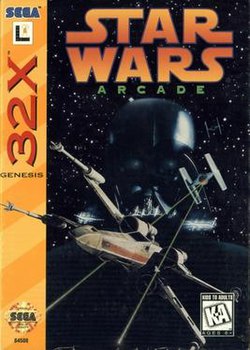This article needs additional citations for verification .(January 2014) |
| Star Wars Arcade | |
|---|---|
 North American 32X cover art | |
| Developer | Sega AM3 R&D [a] |
| Publishers | Sega LucasArts |
| Composers | Hiroshi Kawaguchi Kazuhiko Nagai Youichi Ueda |
| Series | Star Wars |
| Platforms | Arcade, 32X |
| Release | Arcade32X |
| Genres | Action, space simulation |
| Modes | Single-player, multiplayer |
| Arcade system | Sega Model 1 |
Star Wars [1] is a 1993 action space simulation arcade game developed and published by Sega. The game is based on the original Star Wars trilogy. Combining elements of A New Hope and Return of the Jedi , the game has players pilot a Rebel starship and battle against the forces of the Empire. Sega developed Star Wars for their Model 1 system, the same arcade hardware that powered Virtua Fighter and Virtua Racing . Like those two titles, the graphics in Star Wars are rendered entirely using polygons. The game was given a home port under the name Star Wars Arcade, as an exclusive for the 32X's launch in 1994.
Contents
Sega followed up the release of Star Wars Arcade with Star Wars Trilogy Arcade and Star Wars: Racer Arcade , as well as a Star Wars pinball game.